Welcome back to Magic Gatherings!
It’s that time again. A new set is around the corner, prerelease tournaments are this weekend, and I’ve spent the weekend crunching numbers to review the set for limited play. First we’ll review the major mechanics, then we’ll put it all together with some overarching thoughts about Battle for Zendikar‘s limited environment as a whole.
Battle for Zendikar is an unusually complex set, but one I think will particularly reward players who develop a solid plan for their decks and select cards that really contribute to that plan. That means we’ll have plenty to talk about. But first, a word from the DCI.
A WORD FROM THE DCI
Before I get started on that, though, there is one ultra-important unmissable thing about this set. If you take nothing else away from this article, it’s this: the “mulligan rule” changes as of the beginning of the Battle for Zendikar pre-release.
I’ll say it again, in all caps:
THE MULLIGAN RULE IS CHANGING WITH THIS SET.
As you might already know, when you’re playing in a sanctioned (read: official) tournament, each player has the opportunity to mulligan their opening hand at the beginning of the game: if they don’t like what they draw, they can shuffle their hand back into their deck and draw a new hand with one fewer card. This process can continue until the player decides to keep a hand, so you can “mull to six,” then to five, then four, and so on, depending on how horribly unlucky you happen to be.
The new mulligan rule is this: if you mulligan, once you decide to keep a starting hand, you can then scry 1: you look at the top card of your deck, and can then put that card on the bottom of your deck, or back on top—your choice.
Please note that you can only scry once you’re done taking mulligans and have decided to keep a hand. You don’t get a free scry in between each mulligan. This latter part is important, so be sure to communicate clearly with your opponent that you have decided to keep, before you take your scry. Ask that they do the same.
If you don’t mulligan, no free scry for you. Too bad! Your opening hand was good! Life’s tough.
If you’re a strategic type, the new mulligan rule means your your six-card hands will be a little bit more likely to function like a normal Magic hand. So you can be slightly more aggressive about mulliganing a borderline seven-card opening hand (since your six-card hand will be a little better), and slightly more willing to keep a borderline six-card opening hand after you mulligan (since your free scry makes it a little more likely that your hand works out). If you want to read more, I recommend this great article by Hall of Famer and math wonk Frank Karsten.
Okay! Enough tournament rules. Let’s get to it!
BFZ‘s Mechanics
A set’s mechanics are the key component to the fabric of its limited play. With that in mind, we’ll go through Battle for Zendikar‘s new tools to see how they might affect limited play. (If you want a more general overview of BFZ‘s mechanics, you can find that in the set overview here.)
Awaken
The latest in a long line of kicker-type mechanics, spells with awaken give you the option to pay a higher cost when you cast them. If you do, they animate a land for you, turning it into a creature, and put several +1/+1 counters on that creature.
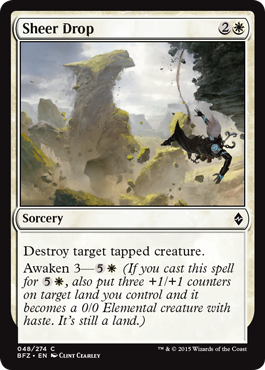
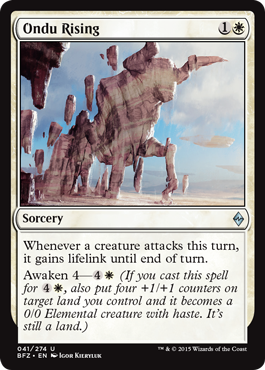 That seems simple enough. But what does it mean for gameplay?
That seems simple enough. But what does it mean for gameplay?
The first question is exactly how you should approach cards with awaken. Are they really spells? Are they really creatures? The latter question seems counterintuitive, but consider a card like [mtg_card]Ondu Rising[/mtg_card]. Are you really ever going to play that as a spell? You might, but you’re probably primarily interested in the creature half.
A more useful way to look at awaken spells, one proposed by Ari Lax over at Star City games, is to consider them as the opposite of spells with evoke. If you put [mtg_card]Coastal Discovery[/mtg_card] next to all-time great [mtg_card]Mulldrifter[/mtg_card], you can see the similarity:
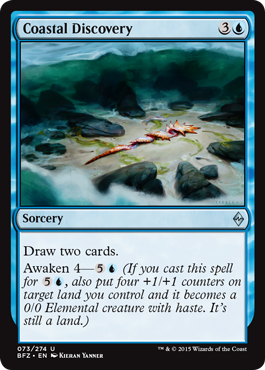
 In both cases, the spell mode (“draw two”) is less expensive than the creature mode, but in both cases you can also get a creature along with your cards if you can pay the extra mana.
In both cases, the spell mode (“draw two”) is less expensive than the creature mode, but in both cases you can also get a creature along with your cards if you can pay the extra mana.
With awaken, it’s important to note that there’s actually also a “hidden” third mode. If you happen to cast a spell for its awaken cost when you have more lands than you need, you can awaken an untapped land—which can immediately attack. This is particularly important, because awaken is centered in blue and white, which are colors that don’t normally get access to 4/4 creatures with haste, not even for six mana. Be careful as you consider attacks and blocks in the late game if your life total is low, since you might wind up dealing with an extra creature you didn’t expect.
For the most part, the creature awaken creates is a reasonable body. As we’ll see later in the article, 4/4 seems to be the break point for a “big” creature in Battle for Zendikar limited. A 3/3 is a respectable addition to the board, and a 4/4, even as late as turn six or seven, is a threat your opponent needs to pay attention to. Strategically, this means that “normal” decks (i.e., ones that have a normal curve and probably don’t have any Eldrazi) get some late-game staying power. As a caveat, if your plan does include some super-expensive spells, be careful with awaken: getting your land-creature killed makes that [mtg_card]Eldrazi Devastator[/mtg_card] a lot harder to cast.
A few more strategic notes: first, there’s nothing that says you can’t awaken a land that’s already a creature. Often, it will be best to load up one land with +1/+1 counters from multiple awaken spells to make it the biggest creature on the battlefield. (It also makes casting spells easier, since you sacrifice fewer “creatures” by tapping them for mana.) Awaken also makes spells that return creatures to their owner’s hand much better—if you return an awakened land, it will come back as a normal land, so you effectively “kill” it.
So when do you play awaken spells? Cards like [mtg_card]Sheer Drop[/mtg_card] are the “easy mode,” as each half of the card is a good deal on its own. I think [mtg_card]Coastal Discovery[/mtg_card] and [mtg_card]Clutch of Currents[/mtg_card] definitely qualify as well. For the rest, consider whether you’d want either half in your deck individually. If you do, or if it’s a borderline case, I think the awaken spell makes the cut, since the flexibility awaken offers does add some value to the card.
Landfall
The first of two returning mechanics, landfall was responsible for making the original Zendikar one of the most aggressive limited formats of all time. It makes sense, when you think about it: if your creatures get better when you play a land, they’ll have that bonus on your turn (which is when you can make land drops). Creatures that are better on your turn (and, by extension, worse on your opponent’s turn) mean you have incentive to attack whenever you can. Just take a look at [mtg_card]Plated Geopede[/mtg_card].
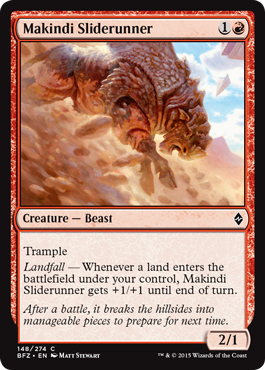
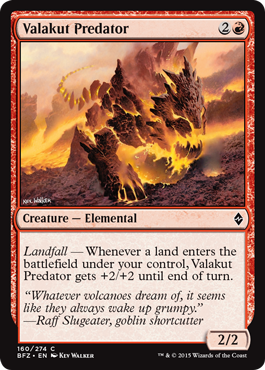 The first time around, landfall creatures that received stat bonuses all got +2/+2 until end of turn for each landfall trigger. In Battle for Zendikar, the development team has tweaked the landfall values a little bit. Cheaper, early game creatures, like [mtg_card]Snapping Gnarlid[/mtg_card] and [mtg_card]Makindi Sliderunner[/mtg_card], get +1/+1 until end of turn for each land you play. More expensive creatures still get the traditional +2/+2. ([mtg_card]Valakut Predator[/mtg_card] straddles the middle, and I think it will be a very good card because of it.) This division is surely to prevent players from getting completely overwhelmed by fast starts from landfall decks, but it also introduces an elegant little tension: the cheaper creatures, which should reliably trigger every turn as you develop your board, don’t get quite as big a bonus. On the other hand, because the more expensive creatures enter the battlefield later, you presumably don’t have as many lands left to play. Luckily, most of the big landfall creatures have some kind of evasive ability, so they can end the game with just a few triggers. (Do note that some creatures have unique abilities, so be sure to read each card with landfall carefully.)
The first time around, landfall creatures that received stat bonuses all got +2/+2 until end of turn for each landfall trigger. In Battle for Zendikar, the development team has tweaked the landfall values a little bit. Cheaper, early game creatures, like [mtg_card]Snapping Gnarlid[/mtg_card] and [mtg_card]Makindi Sliderunner[/mtg_card], get +1/+1 until end of turn for each land you play. More expensive creatures still get the traditional +2/+2. ([mtg_card]Valakut Predator[/mtg_card] straddles the middle, and I think it will be a very good card because of it.) This division is surely to prevent players from getting completely overwhelmed by fast starts from landfall decks, but it also introduces an elegant little tension: the cheaper creatures, which should reliably trigger every turn as you develop your board, don’t get quite as big a bonus. On the other hand, because the more expensive creatures enter the battlefield later, you presumably don’t have as many lands left to play. Luckily, most of the big landfall creatures have some kind of evasive ability, so they can end the game with just a few triggers. (Do note that some creatures have unique abilities, so be sure to read each card with landfall carefully.)

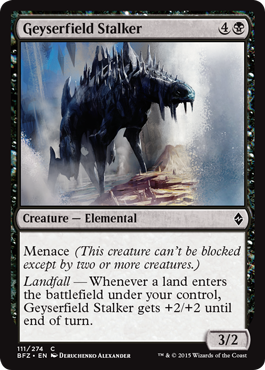 As you might expect, landfall encourages you to play a slightly higher land count than you otherwise might—maybe 18 lands, in your average BFZ limited deck. In turn, it also means that you should think ahead before you reflexively play a land each turn—if you hold extra lands in your land, you can get extra landfall triggers later. (Of course, if you have a big Eldrazi you can potentially draw and cast, you won’t want to sandbag your lands too much.) It’s an interesting strategic puzzle, one which rewards you for knowing what your deck’s plan is.
As you might expect, landfall encourages you to play a slightly higher land count than you otherwise might—maybe 18 lands, in your average BFZ limited deck. In turn, it also means that you should think ahead before you reflexively play a land each turn—if you hold extra lands in your land, you can get extra landfall triggers later. (Of course, if you have a big Eldrazi you can potentially draw and cast, you won’t want to sandbag your lands too much.) It’s an interesting strategic puzzle, one which rewards you for knowing what your deck’s plan is.
The landfall cards also include a cycle of enchantments—the Retreats—which all seem pretty good. Each one gives you the choice of two good abilities (broadly speaking, one good for an aggressive board state and one good for a defensive board state) whenever you play a land. As with awaken spells, having options are good, and these cards even allow you to go back on your choice when the game state calls for it.
On the whole, landfall will push toward more aggressive decks, especially in draft. In sealed, it’s more important to play landfall creatures that are impactful even when their bonuses aren’t in effect, though that’s not hard. The more expensive landfall creatures don’t naturally fight as well with other things at their mana costs, but if you can trigger their abilities late into the game they can make for a reasonable win condition alongside or in lieu of Eldrazi.
Rally and Allies
Rally (and its associated creature type, Ally) is the other set mechanic which pushes toward aggression. Creatures with rally abilities look for creatures with a specific creature type—Ally—to enter the battlefield under your control. When that happens, they do a special cheerleading routine that gives all your creatures a bonus, usually a keyword ability. (All creatures with rally are allies themselves, and they do trigger when they themselves enter the battlefield.) This will usually happen on your turn, so as with landfall, Rally makes you want to attack, since that’s when your creatures are better.

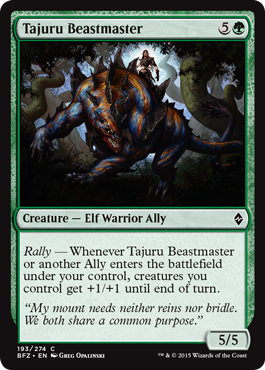 Because creatures with Rally trigger when they enter the battlefield, they’re never worse than a creature that gives your team a bonus when it comes into play. On the other hand, because you need to trigger them every turn, they’re not as good as, say, a hypothetical creature that granted that particular keyword ability all the time, always. So if you’re interested in triggering them, you’ll want to look for Ally creatures. And here you’ll need to read carefully, again: unfortunately, it’s not easy to tell at a glance what creatures are allies and what creatures aren’t—there’s not a recurring visual cue or naming convention that makes the creature type more obvious. You’ll need to pay close attention during drafting, deckbuilding, and gameplay to make sure you get the most out of your allies. For what it’s worth, most of the rally creatures have abilities that don’t stack especially well, meaning you’re more often interested in triggering them once each turn, rather than several times in one turn. The green rally creatures (Tajuru Beastmaster and Tajuru Warcaller), as well as [mtg_card]Kalastria Healer[/mtg_card], are notable exceptions.
Because creatures with Rally trigger when they enter the battlefield, they’re never worse than a creature that gives your team a bonus when it comes into play. On the other hand, because you need to trigger them every turn, they’re not as good as, say, a hypothetical creature that granted that particular keyword ability all the time, always. So if you’re interested in triggering them, you’ll want to look for Ally creatures. And here you’ll need to read carefully, again: unfortunately, it’s not easy to tell at a glance what creatures are allies and what creatures aren’t—there’s not a recurring visual cue or naming convention that makes the creature type more obvious. You’ll need to pay close attention during drafting, deckbuilding, and gameplay to make sure you get the most out of your allies. For what it’s worth, most of the rally creatures have abilities that don’t stack especially well, meaning you’re more often interested in triggering them once each turn, rather than several times in one turn. The green rally creatures (Tajuru Beastmaster and Tajuru Warcaller), as well as [mtg_card]Kalastria Healer[/mtg_card], are notable exceptions.
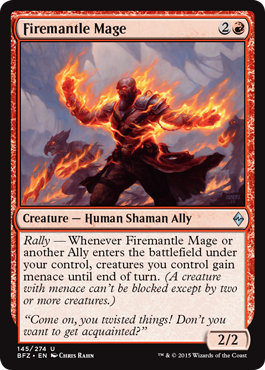
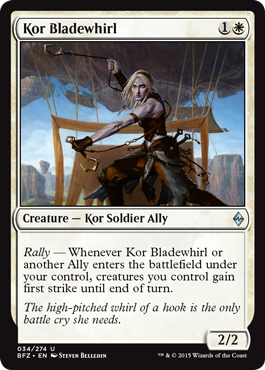 And what is it that you can get? Well, most of the common rally creatures are a little unexciting—they grant things like trample or vigilance, and it’s hard to predict whether those will be relevant in an actual game. (That said, most creatures with rally abilities are reasonably sized for their costs, so it’s not like you give up anything to have the option.) The uncommon rally creatures promise some more serious rewards, though: abilities like haste, first strike, menace, or double strike. You’ll note that these seem like they would be good at breaking up board stalls and allowing your creatures to push through damage, and I agree. Unfortunately, especially in sealed, you don’t have as much control over whether or if you get these. I suspect the “ally deck” will be mostly a draft archetype that tries to hit hard and use these uncommon abilities to overwhelm opponents.
And what is it that you can get? Well, most of the common rally creatures are a little unexciting—they grant things like trample or vigilance, and it’s hard to predict whether those will be relevant in an actual game. (That said, most creatures with rally abilities are reasonably sized for their costs, so it’s not like you give up anything to have the option.) The uncommon rally creatures promise some more serious rewards, though: abilities like haste, first strike, menace, or double strike. You’ll note that these seem like they would be good at breaking up board stalls and allowing your creatures to push through damage, and I agree. Unfortunately, especially in sealed, you don’t have as much control over whether or if you get these. I suspect the “ally deck” will be mostly a draft archetype that tries to hit hard and use these uncommon abilities to overwhelm opponents.
One last thing to note: even though rally abilities only trigger when Ally creatures enter the battlefield, their bonuses apply to all your creatures. This is especially important with the green rally creatures, who give +1/+1 or +2/+2 to all your creatures (and who are great), including any random 1/1 Eldrazi Scion tokens that are running around. It’s a bit of a flavor conflict, but that’s your prerogative as a planeswalker.
Converge
The last “Zendikari” mechanic, converge rewards you for playing as many different colors of mana as you can to play your spells.
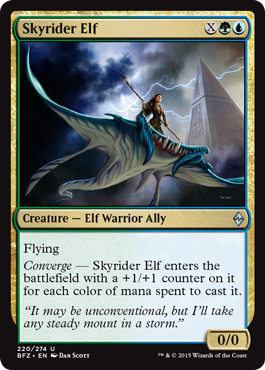
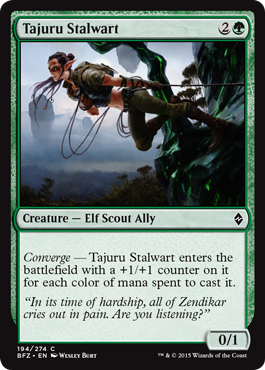 Simply put, I don’t really see converge doing too much in limited play. There is not a lot of manafixing outside green—really just [mtg_card]Evolving Wilds[/mtg_card] and [mtg_card]Pilgrim’s Eye[/mtg_card]—so most “converge decks” will probably be four- or five-color green decks that happen to have a few extra converge cards to power up. It doesn’t help that many of the common and uncommon converge cards don’t seem especially crazy even if you can hit max value on converge—take [mtg_card]Brilliant Spectrum[/mtg_card], for example. One hidden bonus of converge is that (if you’re doing it right) your mana should be good, so you should have some latitude to play powerful cards in other colors. There are some good converge effects at rare, so again, the “converge deck,” such as it is, might be tough to plan around.
Simply put, I don’t really see converge doing too much in limited play. There is not a lot of manafixing outside green—really just [mtg_card]Evolving Wilds[/mtg_card] and [mtg_card]Pilgrim’s Eye[/mtg_card]—so most “converge decks” will probably be four- or five-color green decks that happen to have a few extra converge cards to power up. It doesn’t help that many of the common and uncommon converge cards don’t seem especially crazy even if you can hit max value on converge—take [mtg_card]Brilliant Spectrum[/mtg_card], for example. One hidden bonus of converge is that (if you’re doing it right) your mana should be good, so you should have some latitude to play powerful cards in other colors. There are some good converge effects at rare, so again, the “converge deck,” such as it is, might be tough to plan around.
Ingest/Process
Now we hit the “Eldrazi” mechanics. Technically, ingest and process are two different mechanics, but I’ll deal with them together, since the former will feed the latter in most circumstances. No pun intended.
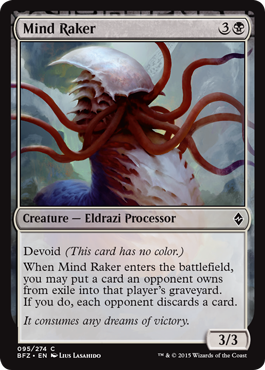
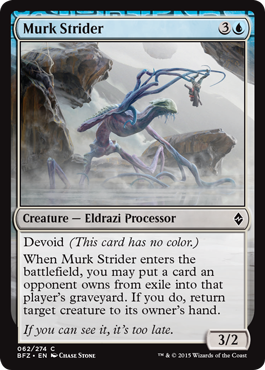 Most of the Processors, especially the common ones, have a small enters-the-battlefield effect which triggers if you “process” your opponent’s cards, moving them from the exile zone to the graveyard, when the processor enters play. These are effects we’re used to seeing—Murk Strider is a dead ringer for Magic Origins draft standout [mtg_card]Separatist Voidmage[/mtg_card]—though they do seem to enjoy a small stat bonus as a trade-off for their ability being harder to trigger. Some of the uncommon processors have splashier abilities, like the counterspell on [mtg_card]Ulamog’s Nullifier[/mtg_card]. A few have abilities you can use over and over again, so long as you have cards to process, and some of these are actually pretty powerful; [mtg_card]Void Attendant[/mtg_card] looks obviously good, and I suspect [mtg_card]Oracle of Dust[/mtg_card] is also pretty strong. As with all the mechanics, however, please read carefully, since some Eldrazi require two cards to process, rather than one.
Most of the Processors, especially the common ones, have a small enters-the-battlefield effect which triggers if you “process” your opponent’s cards, moving them from the exile zone to the graveyard, when the processor enters play. These are effects we’re used to seeing—Murk Strider is a dead ringer for Magic Origins draft standout [mtg_card]Separatist Voidmage[/mtg_card]—though they do seem to enjoy a small stat bonus as a trade-off for their ability being harder to trigger. Some of the uncommon processors have splashier abilities, like the counterspell on [mtg_card]Ulamog’s Nullifier[/mtg_card]. A few have abilities you can use over and over again, so long as you have cards to process, and some of these are actually pretty powerful; [mtg_card]Void Attendant[/mtg_card] looks obviously good, and I suspect [mtg_card]Oracle of Dust[/mtg_card] is also pretty strong. As with all the mechanics, however, please read carefully, since some Eldrazi require two cards to process, rather than one.

 Feeding your processors will be a little more complicated. While there are incidental exile effects on a lot of cards in this set—[mtg_card]Horribly Awry[/mtg_card] and [mtg_card]Transgress the Mind[/mtg_card], for example—by and large you’ll get cards into exile by attacking with creatures that have ingest. As with the processors, some of these cards are clearly good enough even without the ingest ability tacked on—[mtg_card]Benthic Infiltrator[/mtg_card], for example. Others, like [mtg_card]Culling Drone[/mtg_card], seem like they may get outclassed quickly—remember, you have to actually hit with the creature to ingest the card. Still others, like [mtg_card]Salvage Drone[/mtg_card], don’t look like the sort of card I’d normally put in a limited deck. The card that’s currently drawing the most focus is [mtg_card]Mist Intruder[/mtg_card], which is just barely weaker than something I’d want to play. Does the fact that it has ingest make it playable? That depends a lot on how many processors you have and what they do.
Feeding your processors will be a little more complicated. While there are incidental exile effects on a lot of cards in this set—[mtg_card]Horribly Awry[/mtg_card] and [mtg_card]Transgress the Mind[/mtg_card], for example—by and large you’ll get cards into exile by attacking with creatures that have ingest. As with the processors, some of these cards are clearly good enough even without the ingest ability tacked on—[mtg_card]Benthic Infiltrator[/mtg_card], for example. Others, like [mtg_card]Culling Drone[/mtg_card], seem like they may get outclassed quickly—remember, you have to actually hit with the creature to ingest the card. Still others, like [mtg_card]Salvage Drone[/mtg_card], don’t look like the sort of card I’d normally put in a limited deck. The card that’s currently drawing the most focus is [mtg_card]Mist Intruder[/mtg_card], which is just barely weaker than something I’d want to play. Does the fact that it has ingest make it playable? That depends a lot on how many processors you have and what they do.
I can imagine decks where the ingest/process engine is fully online and your cards are just more powerful than your opponent’s—bigger, extra abilities, and so forth. Those decks would rely on a steady stream of ingested cards. So, in turn, you’d need to be hitting for at least the first few turns with ingest creatures, and might even want some permanent, reliable source (again, see [mtg_card]Benthic Infiltrator[/mtg_card]). But at that point, you may be putting suboptimal cards in your deck.
My instinct is to say that dedicated ingest/process decks can work, but that for the prerelease it’s probably best to stick to processors that are reasonable even if you can’t get the extra ability. If you have especially powerful multi-card processors (like [mtg_card]Blight Herder[/mtg_card], say), then you might think about bringing in some extra exile to make sure your spells stay fueled. It is certainly possible I’m underestimating how many cards you can exile without ingest creatures, so be sure to stay flexible in your deck construction and adjust as needed.
Colorless Cards
The other overarching mechanical theme to the Eldrazi is that they’re colorless. On lots of Battle for Zendikar cards, this is represented with the devoid ability, which does what it says on the tin: it makes creatures colorless, even if they require specific colors of mana in their mana costs.
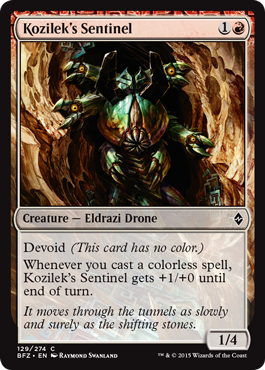
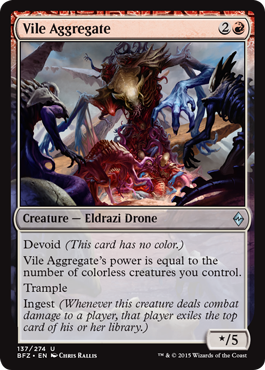 Devoid gives rise to a “colorless matters” theme that’s pretty similar to what we’ve seen in a lot of tribal sets in the past, so there’s not a lot to say here; once you have a lot of colorless cards like this, you want a lot more to make your cards even better.
Devoid gives rise to a “colorless matters” theme that’s pretty similar to what we’ve seen in a lot of tribal sets in the past, so there’s not a lot to say here; once you have a lot of colorless cards like this, you want a lot more to make your cards even better.
One thing to remember is that the set also features a number of colorless cards that are just straight colorless—at common, we have cards like [mtg_card]Kozilek’s Channeler[/mtg_card], [mtg_card]Eldrazi Devastator[/mtg_card], and [mtg_card]Ruin Processor[/mtg_card]. These cards don’t require mana of any color, and their frames look slightly different than devoid frames do, so don’t forget that they actually play for the same devoid team. This dissonance is exacerbated by the fact that many of the less expensive “colorless matters” cards seem to point toward an aggressive deck that’s not as interested in ramping to a giant monster.
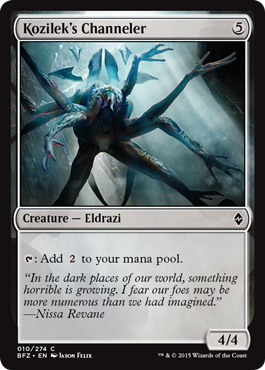
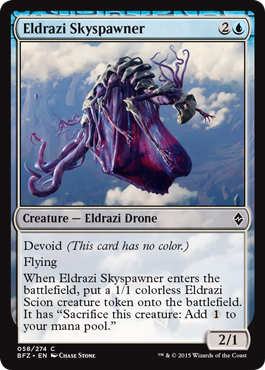 On the topic of ramping, though, there’s one more set of cards we have to talk about: the Eldrazi Scions, little 1/1 tokens that are put into play by various creatures and spells. All Scions have an ability that allows you to sacrifice them at any time to add a colorless mana to your mana pool.
On the topic of ramping, though, there’s one more set of cards we have to talk about: the Eldrazi Scions, little 1/1 tokens that are put into play by various creatures and spells. All Scions have an ability that allows you to sacrifice them at any time to add a colorless mana to your mana pool.
Scions are pretty flexible creatures, and I think they’ll have a big impact on Battle for Zendikar limited play. In the first place, they give you additional ways to ramp up to your big Eldrazi, as totally reasonable creatures like [mtg_card]Eldrazi Skyspawer[/mtg_card] come with a coupon for a free mana that you can cash in whenever you want. (Scions also, in turn, make bounce spells a little better, since it’s no longer guaranteed that your opponent will have the mana to replay the giant Eldrazi you return to their hand.)
Scions also function as creatures, so as we mentioned before, they can get your bonuses from rallying. Flavor fail, but I suspect green-white decks will be especially interested in this. Finally, Scions draw out the game: they make x/1 creatures much worse, and they chump block well when they need to. Compared to the thopter theme in Magic Origins—one I admit I overestimated the impact of—there look to be a lot Scions running around around. Like Origins, Scions are centered in just a few colors (green and blue, with a few in black), but there are more spells at common and uncommon which make them, so I think they’ll be more prevalent overall.
Phew! That’s a lot of talking about mechanics. Let’s start putting together some overarching ideas about how the Battle for Zendikar limited environment will play out.
Color Considerations
In previous set reviews, I’ve given tables of each color for the powers and toughnesses of each of its creatures. I’ve eschewed that approach this time in the interest of space; it doesn’t hurt that true-colorless Eldrazi means that every deck has access to a very high top end. But I’d be remiss if I didn’t talk about what it looks like each color will be good at, at least briefly:
- White got some of the best removal in the set this time around. On balance white’s creatures are a little undersized—this set features a lot of 2/3, 3/2, and 3/3 creatures, which is where white’s creatures seem to top out. (All colors, of course, can play [mtg_card]Kozilek’s Channeler[/mtg_card].) This naturally lends itself to an aggressive gameplan, though I suspect that aggressive decks won’t quite come together in sealed. White also has some efficient flyers and ways to lock up the ground. It lacks native ways to ramp to big Eldrazi, so base-white decks may look a little more like a normal limited deck, topping out around six mana for awaken spells.
- Blue has a lot of different elements—some devoid creatures, some ingest creatures, some Processors, some awaken spells, some flyers, some Scion token generation. A lot of these cards are pretty strong, too, so blue should be valuable support for whatever theme your deck is based around. As a corollary, blue’s removal is weaker—[mtg_card]Tightening Coils[/mtg_card], basically, but because of Awaken we can probably count bounce spells. [mtg_card]Clutch of Currents[/mtg_card], in particular, looks excellent.
- Black has a few standout removal spells, but most of its commons are simply efficient, not eye-popping. It also has a smattering of Scion generation and a lone rally creature in Kalastria Healer, which could inspire different kinds of ally decks. Black also has a lot cards that trigger abilities when you gain life (a theme it shares with white) and cards that care about sacrificing creatures (a theme it shares with green).
- Red is a bit like blue, with its cards spread over several different themes: rally, landfall, and some devoid. Its cards don’t seem quite as strong individually as blue’s, but it does have several standouts, particularly [mtg_card]Valakut Predator[/mtg_card], which is much bigger than other creatures at its mana cost, as long as you’re triggering landfall. Red does have some really excellent removal in this set—[mtg_card]Stonefury[/mtg_card] might look a little clunky, but it scales pretty well as the game goes along. At uncommon, watch out for [mtg_card]Turn Against[/mtg_card], which can steal an attacking creature at instant speed.
- Green seems mostly interested in Scion generation and (by extension) ramp, with a few large creatures at the top end of its curve. Naturally, you won’t want to stop there, so you will probably be playing [mtg_card]Eldrazi Devastators[/mtg_card] and [mtg_card]Ruin Processors[/mtg_card] alongside your green acceleration. All those tokens help black’s sacrifice theme, and there are a few landfall cards and some good high-end rally cards to boot.
Removal

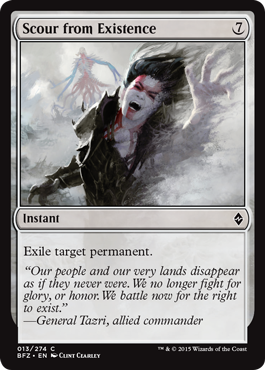 Alongside a set’s mechanics and creatures sizes, its removal is the third major factor in defining its limited environment. Removal in Battle for Zendikar is in kind of a weird place: there’s a good bit of it, but it seems particularly split into two camps—inexpensive, tempo-efficient removal that only kills smaller creatures, and more expensive, more flexible removal that will probably take your entire turn to cast. This suggests to me that, one the whole, the removal serves to slow the limited environment down a bit. (Normally you’d expect a set with lots of efficient removal to be a little faster. BFZ has lots of removal, but only some of it is truly efficient.) Several pros have mentioned that loading up on “bad removal” may be a real thing in this set—so, again, know your deck’s plan, and bias toward the removal that is flexible but still relatively efficient, if you have the option. If you want to read more, Hall of Fame pro Paulo Vitor Damo da Rosa just published a good article on Battle for Zendikar limited, which includes a comprehensive section on removal.
Alongside a set’s mechanics and creatures sizes, its removal is the third major factor in defining its limited environment. Removal in Battle for Zendikar is in kind of a weird place: there’s a good bit of it, but it seems particularly split into two camps—inexpensive, tempo-efficient removal that only kills smaller creatures, and more expensive, more flexible removal that will probably take your entire turn to cast. This suggests to me that, one the whole, the removal serves to slow the limited environment down a bit. (Normally you’d expect a set with lots of efficient removal to be a little faster. BFZ has lots of removal, but only some of it is truly efficient.) Several pros have mentioned that loading up on “bad removal” may be a real thing in this set—so, again, know your deck’s plan, and bias toward the removal that is flexible but still relatively efficient, if you have the option. If you want to read more, Hall of Fame pro Paulo Vitor Damo da Rosa just published a good article on Battle for Zendikar limited, which includes a comprehensive section on removal.
Battle Plans
All right, time to start putting these observations together. What will Battle for Zendikar limited look like?
In the first place, I think it will be slower than Magic Origins limited. Unlike renown, the aggressive mechanics don’t provide permanent bonuses to your creatures. That means that aggressive decks will probably hit a point where they look to build up their forces and break through on a critical turn, rather than getting ahead and staying ahead by eliminating opposing creatures before they can block.
 2/3, 3/2, and 3/3 seem to be the characteristic sizes of creatures in this format. Most colors can produce a 2/3 by turn three, so I’m not sure how the humble 2/2—the bread and butter of so many limited formats—will fare this time around. More interestingly, most colors also have access to a common, high-toughness blocker, and several of them are pretty attractive, like our friend [mtg_card]Silent Skimmer[/mtg_card], or [mtg_card]Benthic Infiltrator[/mtg_card], or [mtg_card]Kozilek’s Sentinel[/mtg_card] (in red!). Compare that to Magic Origins, where [mtg_card]Returned Centaur[/mtg_card] was a good blocker, but never a card you were excited to be playing.
2/3, 3/2, and 3/3 seem to be the characteristic sizes of creatures in this format. Most colors can produce a 2/3 by turn three, so I’m not sure how the humble 2/2—the bread and butter of so many limited formats—will fare this time around. More interestingly, most colors also have access to a common, high-toughness blocker, and several of them are pretty attractive, like our friend [mtg_card]Silent Skimmer[/mtg_card], or [mtg_card]Benthic Infiltrator[/mtg_card], or [mtg_card]Kozilek’s Sentinel[/mtg_card] (in red!). Compare that to Magic Origins, where [mtg_card]Returned Centaur[/mtg_card] was a good blocker, but never a card you were excited to be playing.
As we mentioned above, the ground will get further cluttered with the Eldrazi Scions skittering about. In the past I’ve tended to overestimate the impact and density of set mechanics (namely Thopters), but I do think Scions will be an important feature of the BFZ limited environment, particularly out of blue and green decks. Again, Scions help draw the game out (by chump-blocking) or reach more expensive spells more quickly (which, as we mentioned, are harder for the cheap removal to kill). That means that decks that want to stall the game until they cast their big Eldrazi, should be able to.
Those giant Eldrazi will be a major feature of the limited environment. I had similar thoughts about the dragons in Dragons of Tarkir, and those wound up not being as important as I thought they’d be. So what’s different?
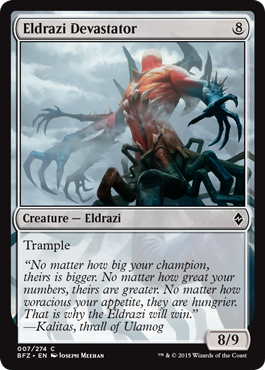
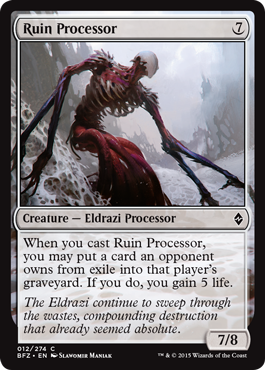 First, the large colorless Eldrazi are much, much bigger than anything else around. The eponymous dragons were largely 4/4s, and those could be challenged by regular creatures, like [mtg_card]Aerie Bowmasters[/mtg_card]. Nothing at common is tangling with Eldrazi Devastor or Ruin Processor. They will hit the board and matter.
First, the large colorless Eldrazi are much, much bigger than anything else around. The eponymous dragons were largely 4/4s, and those could be challenged by regular creatures, like [mtg_card]Aerie Bowmasters[/mtg_card]. Nothing at common is tangling with Eldrazi Devastor or Ruin Processor. They will hit the board and matter.
They’re also realistically priced. Seven mana is a lot (and at high mana costs, each additional mana matters more than you’d think), but it’s within reach, particularly if you’re helping out with [mtg_card]Kozilek’s Channeler[/mtg_card] or [mtg_card]Eldrazi Scions[/mtg_card]. At uncommon there are monsters like [mtg_card]Breaker of Armies[/mtg_card] and [mtg_card]Bane of Bala Ged[/mtg_card], which threaten to wreck your opponent’s board if you ever get to untap with them.
Finally, since the removal tends toward killing smaller creatures cheaply or killing anything for a large price, decks may be stranded with the wrong answer at the wrong time. In Dragons draft, something like Epic Confrontation was great at forcing through damage early or killing a dragon late (provided you had a big enough creature). For an aggressive deck to succeed, it will need to be able to kill early blockers and still have a [mtg_card]Smite the Monstrous[/mtg_card] in reserve for the big boss.
This seems mostly achievable in draft, where (to risk oversimplifying) I think we’ll generally see decks tend either toward an aggressive, tempo style, or toward a defensive, late-game ramp style. (There are actually a lot of archetypes baked into Battle for Zendikar, which I’ll talk about more next week.) For the prerelease, while it’s possible you’ll open aggressive creatures and multiple [mtg_card]Clutch of Currents[/mtg_card] to back them up, I think it’s more likely that decks will bias toward being slower, surviving to the late game, and smashing with giant Eldrazi when they get there.
One last PSA!
A final word of advice: as we’ve mentioned briefly before, Battle for Zendikar also features the ultra-rare, ultra-premium Zendikar Expeditions. These are all going to be very valuable, but no one is really sure how much yet—prices range from $50 for the “Battle Lands” to $400 for [mtg_card]Scalding Tarn[/mtg_card] and [mtg_card]Misty Rainforest[/mtg_card].
These have generated tons of buzz, but some players may not know what they are. If you see people who are confused, help them out! Explain they are very lucky and got a very rare card, which is probably worth a lot of money. (They are also welcome to play it in their deck, if they want.) And keep an eye out for hustlers: there may be some dishonest people who try to fleece lucky Expeditioneers, particularly if the person who opens them is young. Don’t be that person, and don’t let anyone else be that person either.
That’s all for this week. Good luck at your prerelease this weekend, and I hope some of you open Expeditions of your own!
